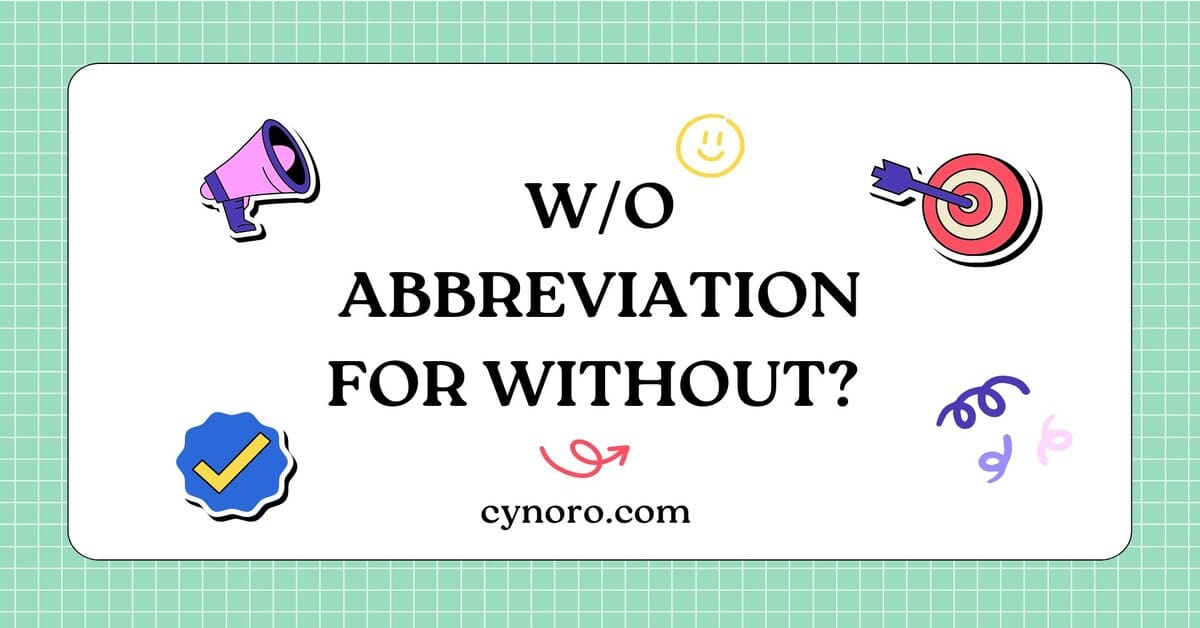The abbreviation for “without” is a small but mighty symbol you’ll likely encounter all over the place. Whether you’re texting, writing notes, or browsing online, it’s a simple shortcut that can save you time and effort. But do you know the most commonly used abbreviation for it and how to use it correctly?
In this article, we’ll explore everything you need to know about this handy abbreviation. By the end, you’ll be using it like a pro, making your communication faster and more efficient. Let’s dive in!
What is the Abbreviation for Without?
The abbreviation for “without” is “w/o”. It’s formed by taking the first letter “w” from “without” and combining it with the letter “o” to represent the final sound in the word. This shorthand is incredibly useful for saving space, particularly in notes, text messages, and informal writing.
This abbreviation is informal in nature and is not typically used in formal or academic writing. However, you’ll see it often in personal communications, technical writing, or any place where brevity is essential.
What Does Without Mean?
“Without” is a preposition in the English language. It expresses absence or lack of something. It signifies that something is missing, excluded, or not present.
For example:
- “I can’t imagine life without music.”
- “She went to the party without her coat.”
In both sentences, “without” indicates something that is absent—music in the first, and a coat in the second.
Short Abbreviation for Without: “w/o”
The shorthand “w/o” serves the same function as the full word “without.” It is widely used to simplify writing, especially when space is limited or when a more casual, informal tone is needed.
Key Points About “w/o”:
- Shortened form: The abbreviation “w/o” is simply a contraction of the word “without.”
- Informal: It’s mainly used in informal writing, such as texts, emails, lists, and casual notes.
- Common in Technical Writing: In some specialized contexts like instructions or medical records, abbreviations like “w/o” are used to save time and space.
Acronym for Without: Is “w/o” an Acronym?
Many people mistakenly think of “w/o” as an acronym, but it is actually an abbreviation, not an acronym.
What’s the Difference?
- Acronyms are created by using the initial letters of multiple words (like “NASA” for National Aeronautics and Space Administration).
- Abbreviations, on the other hand, shorten individual words (like “w/o” for “without” or “b/c” for “because”).
Thus, “w/o” is not an acronym, but rather a common abbreviation for the word “without.”
How to Pronounce “w/o”
When you see “w/o” written, you will likely pronounce it as “without”, since that’s the full word it represents. Most people pronounce it the same way, whether in formal or casual conversation.
- Pronunciation: “w/o” is pronounced as “without” (/wɪðˈaʊt/), just like the full form of the word.
Even though “w/o” is a shorthand, it’s important to enunciate it clearly in speech if you are reading it aloud, especially in professional or technical contexts.
Synonyms for Without
There are several synonyms for “without” that you might encounter depending on the context. These can help diversify your writing and allow you to convey subtle differences in meaning.
Synonyms for Without:
- Lacking
- Devoid of
- Absence of
- Not having
- Excluding
For example, instead of saying, “He left the house without his phone,” you could say:
- “He left the house lacking his phone.”
- “He left the house devoid of his phone.”
Each synonym carries a slightly different nuance, but all communicate a sense of absence or missing something.
Antonym for Without
The antonym of “without” is “with”.
While “without” indicates something is absent, “with” indicates inclusion or presence.
Examples:
- Without: “She made the recipe without salt.”
- With: “She made the recipe with salt.”
The contrast between “with” and “without” is simple but essential in conveying the presence or absence of something.
The History of the Word “Without”
The word “without” has its origins in Old English. It was formed from the combination of the words “with” and “out,” and has evolved in both spelling and meaning over time.
Etymology of “Without”:
- Old English: The word “wiðutan” or “wiþutan” meant “outside” or “out of,” with “wið” meaning “against” or “with,” and “utan” meaning “outside.”
- Over the centuries, the word simplified to its modern form “without,” which we use today to indicate absence, exclusion, or lack.
This evolution shows how language adapts over time while maintaining its core meanings.
When to Use the Abbreviation “w/o”
Knowing when to use “w/o” is key to effective communication. Here are some scenarios where using “w/o” makes sense:
Common Use Cases for “w/o”:
- Informal Writing: Texts, notes, and casual emails benefit from abbreviations like “w/o.”
- Technical Writing: Instructions, reports, and specifications often use shorthand to save space.
- Lists or Bullet Points: When brevity is essential, especially in lists, you may see “w/o” used frequently.
Avoid Using “w/o” in:
- Formal Writing: Abbreviations like “w/o” are typically not appropriate in formal papers, academic writing, or professional reports.
- Legal Documents: Precision is crucial in legal writing, so spelling out the full word is often preferred.
Examples of the Word and Abbreviations in Context
To better understand how “w/o” fits into everyday use, here are some examples:
Example Sentences with “w/o”:
- “Please submit the form w/o delay.”
- “The menu includes options w/o dairy.”
- “I prefer my pizza w/o mushrooms.”
Example Sentences with “Without”:
- “Please submit the form without delay.”
- “The menu includes options without dairy.”
- “I prefer my pizza without mushrooms.”
The use of “w/o” can make sentences more concise without losing meaning.
Other Common Abbreviations in Use
Just like “w/o” for “without”, many other common abbreviations simplify everyday writing. Here are a few others you might find helpful:
- w/ = “with”
- b/c = “because”
- etc. = “et cetera” (and so on)
- i.e. = “that is” or “in other words”
- e.g. = “for example”
Each of these abbreviations is meant to save time and space, just like “w/o”.
Final Thoughts
The abbreviation “w/o” for “without” is a simple yet powerful tool for efficient writing, particularly in informal contexts or technical documents. Whether you’re texting a friend, drafting a quick note, or working on a report, “w/o” can help convey your message clearly and concisely.
However, it’s important to remember that “w/o” is best suited for casual and technical use. In more formal settings, it’s always safer to spell out “without” in full.
The abbreviation “w/o” may seem small, but its usefulness cannot be understated. From its historical roots to its modern-day applications, it’s an essential part of everyday language that helps us communicate more efficiently. So, the next time you need to shorten “without”, you’ll know just where to turn!

Tony James is an expert blogger at Cynoro, specializing in the English language. With a passion for teaching and writing, he empowers learners to achieve fluency and confidence.








